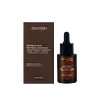What's inside
What's inside
 Key Ingredients
Key Ingredients

 Benefits
Benefits

 Concerns
Concerns

 Ingredients Side-by-side
Ingredients Side-by-side

Water
Skin ConditioningPropylene Glycol
HumectantGlycolic Acid
BufferingNiacinamide
SmoothingSalicylic Acid
MaskingButylene Glycol
HumectantAmylopectin
Xanthan Gum
EmulsifyingDextrin
AbsorbentChamomilla Recutita Flower Extract
MaskingAloe Barbadensis Leaf Juice
Skin ConditioningFucus Vesiculosus Extract
EmollientRubus Idaeus Fruit Extract
AstringentAcer Saccharum Extract
Skin ConditioningPortulaca Oleracea Extract
Skin ConditioningHydroxypropyl Bisstearamide Mea
Skin ConditioningPolyglutamic Acid
Skin ConditioningTetrasodium EDTA
Sodium Hydroxymethylglycinate
PreservativeTriethanolamine
BufferingDipropylene Glycol
HumectantBehenyl Alcohol
EmollientCeteareth-20
CleansingCholesteryl Isostearate
EmollientTricaprylin
MaskingCetearyl Alcohol
EmollientSqualane
EmollientCholesterol
EmollientStearic Acid
CleansingDimethicone
EmollientPhenoxyethanol
PreservativeWater, Propylene Glycol, Glycolic Acid, Niacinamide, Salicylic Acid, Butylene Glycol, Amylopectin, Xanthan Gum, Dextrin, Chamomilla Recutita Flower Extract, Aloe Barbadensis Leaf Juice, Fucus Vesiculosus Extract, Rubus Idaeus Fruit Extract, Acer Saccharum Extract, Portulaca Oleracea Extract, Hydroxypropyl Bisstearamide Mea, Polyglutamic Acid, Tetrasodium EDTA, Sodium Hydroxymethylglycinate, Triethanolamine, Dipropylene Glycol, Behenyl Alcohol, Ceteareth-20, Cholesteryl Isostearate, Tricaprylin, Cetearyl Alcohol, Squalane, Cholesterol, Stearic Acid, Dimethicone, Phenoxyethanol
Water
Skin ConditioningCyclopentasiloxane
EmollientGlycerin
HumectantNiacinamide
SmoothingAluminum Starch Octenylsuccinate
AbsorbentDimethicone
EmollientDimethicone Crosspolymer
Emulsion StabilisingPolyethylene
AbrasivePanthenol
Skin ConditioningTocopheryl Acetate
AntioxidantPalmitoyl Pentapeptide-4
Skin ConditioningSodium PEG-7 Olive Oil Carboxylate
EmulsifyingCeratonia Siliqua Fruit Extract
MaskingPolyacrylamide
Titanium Dioxide
Cosmetic ColorantC13-14 Isoparaffin
EmollientCaprylyl Glycol
EmollientCeramide AP
Skin Conditioning1,2-Hexanediol
Skin ConditioningPhenoxyethanol
PreservativeLaureth-4
EmulsifyingLaureth-7
EmulsifyingDimethiconol
EmollientParfum
MaskingBHT
AntioxidantDisodium EDTA
Citric Acid
BufferingMica
Cosmetic ColorantWater, Cyclopentasiloxane, Glycerin, Niacinamide, Aluminum Starch Octenylsuccinate, Dimethicone, Dimethicone Crosspolymer, Polyethylene, Panthenol, Tocopheryl Acetate, Palmitoyl Pentapeptide-4, Sodium PEG-7 Olive Oil Carboxylate, Ceratonia Siliqua Fruit Extract, Polyacrylamide, Titanium Dioxide, C13-14 Isoparaffin, Caprylyl Glycol, Ceramide AP, 1,2-Hexanediol, Phenoxyethanol, Laureth-4, Laureth-7, Dimethiconol, Parfum, BHT, Disodium EDTA, Citric Acid, Mica
 Reviews
Reviews

Ingredients Explained
These ingredients are found in both products.
Ingredients higher up in an ingredient list are typically present in a larger amount.
Dimethicone is a type of synthetic silicone created from natural materials such as quartz.
What it does:
Dimethicone comes in different viscosities:
Depending on the viscosity, dimethicone has different properties.
Ingredients lists don't always show which type is used, so we recommend reaching out to the brand if you have questions about the viscosity.
This ingredient is unlikely to cause irritation because it does not get absorbed into skin. However, people with silicone allergies should be careful about using this ingredient.
Note: Dimethicone may contribute to pilling. This is because it is not oil or water soluble, so pilling may occur when layered with products. When mixed with heavy oils in a formula, the outcome is also quite greasy.
Learn more about DimethiconeNiacinamide is a multitasking form of vitamin B3 that strengthens the skin barrier, reduces pores and dark spots, regulates oil, and improves signs of aging.
And the best part? It's gentle and well-tolerated by most skin types, including sensitive and reactive skin.
You might have heard of "niacin flush", or the reddening of skin that causes itchiness. Niacinamide has not been found to cause this.
In very rare cases, some individuals may not be able to tolerate niacinamide at all or experience an allergic reaction to it.
If you are experiencing flaking, irritation, and dryness with this ingredient, be sure to double check all your products as this ingredient can be found in all categories of skincare.
When incorporating niacinamide into your routine, look out for concentration amounts. Typically, 5% niacinamide provides benefits such as fading dark spots. However, if you have sensitive skin, it is better to begin with a smaller concentration.
When you apply niacinamide to your skin, your body converts it into nicotinamide adenine dinucleotide (NAD). NAD is an essential coenzyme that is already found in your cells as "fuel" and powers countless biological processes.
In your skin, NAD helps repair cell damage, produce new healthy cells, support collagen production, strengthen the skin barrier, and fight environmental stressors (like UV and pollution).
Our natural NAD levels start to decline with age, leading to slower skin repair, visible aging, and a weaker skin barrier. By providing your skin niacinamide, you're recharging your skin's NAD levels. This leads to stronger, healthier, and younger looking skin.
Another name for vitamin B3 is nicotinamide. This vitamin is water-soluble and our bodies don't store it. We obtain Vitamin B3 from either food or skincare. Meat, fish, wheat, yeast, and leafy greens contain vitamin B3.
The type of niacinamide used in skincare is synthetically created.
Learn more about NiacinamidePhenoxyethanol is a preservative that has germicide, antimicrobial, and aromatic properties. Studies show that phenoxyethanol can prevent microbial growth. By itself, it has a scent that is similar to that of a rose.
It's often used in formulations along with Caprylyl Glycol to preserve the shelf life of products.
Water. It's the most common cosmetic ingredient of all. You'll usually see it at the top of ingredient lists, meaning that it makes up the largest part of the product.
So why is it so popular? Water most often acts as a solvent - this means that it helps dissolve other ingredients into the formulation.
You'll also recognize water as that liquid we all need to stay alive. If you see this, drink a glass of water. Stay hydrated!
Learn more about Water